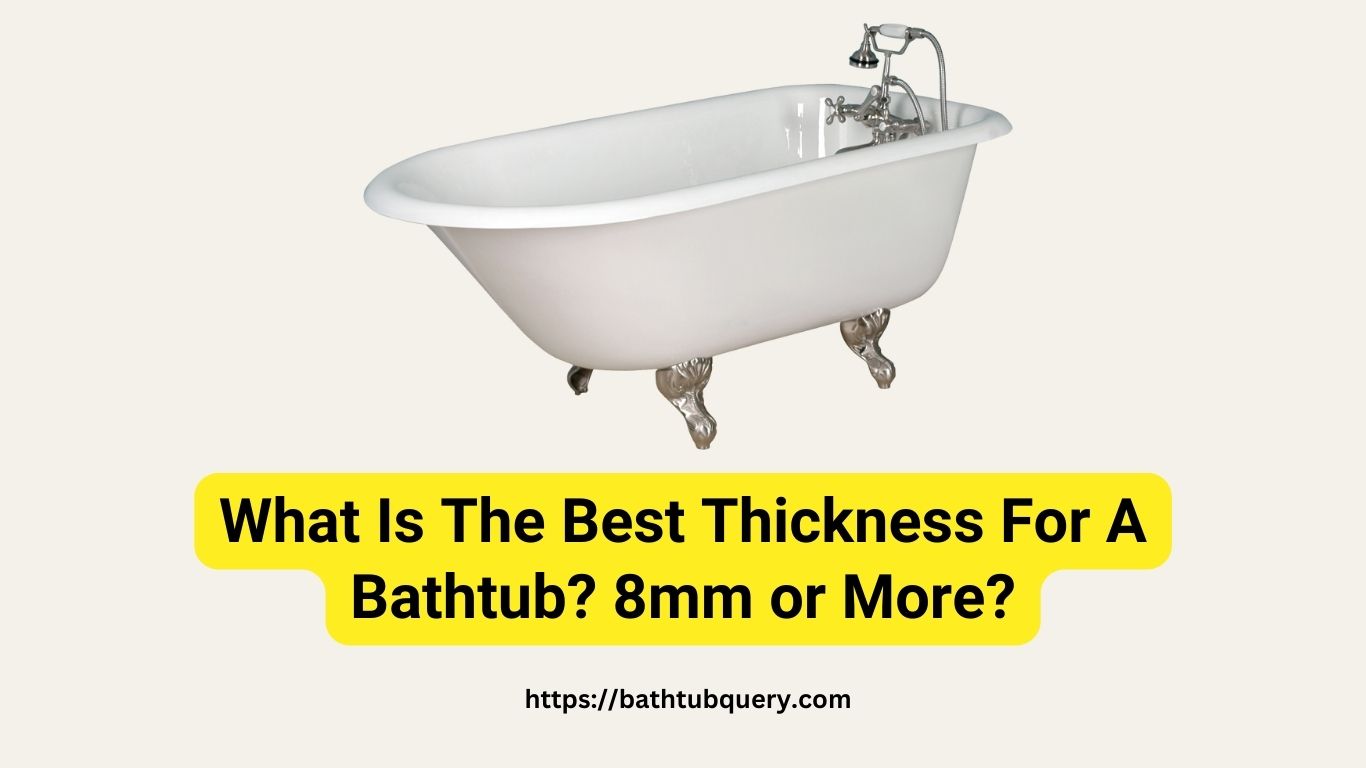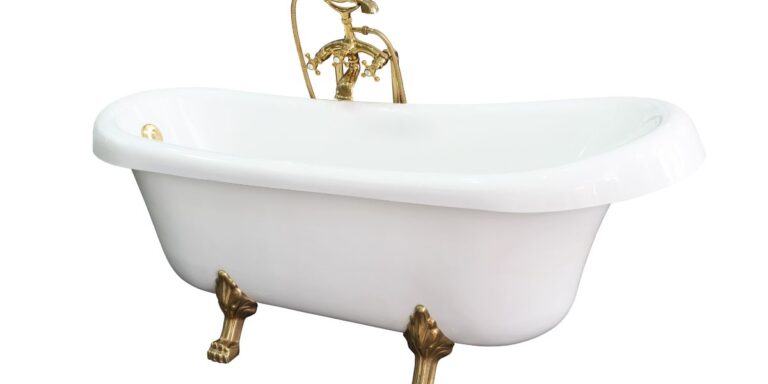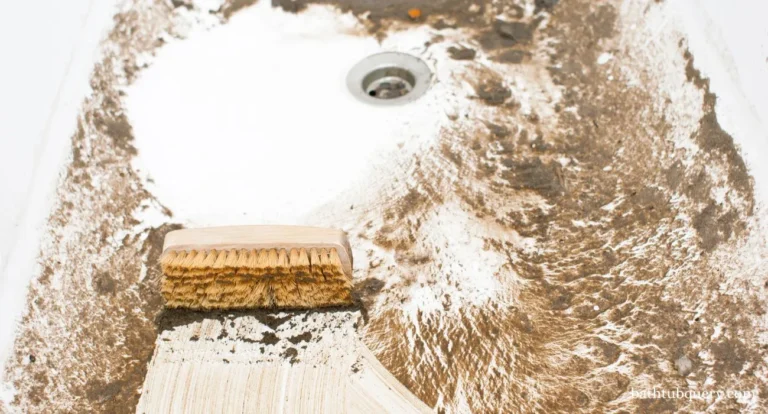What Is The Best Thickness For A Bathtub? 8mm or More?
When it comes to bathtubs, thickness matters. A tub that’s too thin could lead to cracks and leaks down the road. But go too thick, and you’ll have trouble maneuvering it into place or dealing with its hefty price tag. Like Goldilocks testing chairs in the bear’s house, you want a bathtub thickness that’s just right.
But what exactly is the “Goldilocks zone” for bathtub thickness? In this article, we’ll look at the different factors that go into choosing the ideal thickness for your new tub. You’ll learn how thickness impacts durability, insulation, cost, and more, so you can find the tub that’s not too thin, not too thick, but just right for your bathroom and budget.
So, What’s The Ideal Bathtub Thickness?
Bathtubs, especially acrylic ones, should be at least 8 millimeters thick for optimal use. This strikes an excellent mix between longevity and durability, making cracking less likely over time. Acrylic bathtubs are already known for their durability, but double-skinned bathtubs provide an even more long-lasting option.
Balancing Durability and Affordability
Bathtub thickness is measured in millimeters (mm) and can range from as thin as 3 mm for basic acrylic models to over 12 mm for high-end solid surface tubs. As you might expect, thinner tubs come with lower price tags. But they may sacrifice durability.

Thicker tubs, on the other hand, offer more rigidity and resistance to dents and cracks over years of use. But you’ll pay more for the added durability. Finding the sweet spot between price and longevity depends on your budget.
Here’s how some common materials stack up on the thickness scale:
| Material | Thickness Range | Characteristics |
|---|---|---|
| Acrylic | 3-5 mm | Budget-friendly but may flex or develop minor cracks over time. |
| Enameled Steel | 3-4 mm | Good rigidity but vulnerable to chips in enamel over decades. |
| Cast Iron | 4-6 mm | Extremely durable but very heavy. |
| Solid Surface | 6-12 mm | Premium material that’s more flexible than cast iron. |
For most bathrooms, an acrylic or enameled steel tub around 4-5 mm thick provides a good balance. You get decent insulation and durability without breaking the bank. Paying extra for tubs over 6 mm thick is only worth it if you want lengthy hot soaks.
Thickness for a Built-In Bathtub
If you’ll be custom-building a recessed bathtub into the floor or surrounding tile, you may want to aim for a thickness of 5-6 mm. The extra rigidity helps the tub keep its shape when enclosed on three sides.
With freestanding tubs, thickness is less crucial since the tub won’t be surrounded by other structures putting pressure on it. Just make sure any clawfoot or pedestal tub you choose has a durable base that properly supports its weight when full of water.
Insulation and Heat Retention
One benefit of thicker tubs is they retain heat more effectively. This gives you more time to enjoy a nice, long, steamy bath before the water starts cooling off.
On a related note, thicker tubs will also lose less heat through the sides. So you won’t have to run the hot water as often to maintain your desired temperature. This can lead to savings on your energy bills.
To get the best insulation and heat retention, solid-surfaced or cast iron tubs around 6-8 mm thick are ideal. Acrylic and enameled steel lose heat more rapidly, especially when under 5 mm.
Weight Considerations
The thicker the tub, the heavier it will be. This impacts both shipping costs and installation.
For DIY installations, consider both getting the tub into your home as well as maneuvering it into the exact position needed in your bathroom. Extremely heavy cast iron tubs often require professional installation.
Here are rough weights for common tub thicknesses when empty:
| Tub Material & Thickness | Approximate Weight (Empty) |
|---|---|
| 3-4 mm Acrylic | Approximately 40-60 lbs |
| 5 mm Enameled Steel | Around 80-100 lbs |
| 6 mm Solid Surface | Roughly 120-150 lbs |
| 6 mm Cast Iron | Approximately 250-300 lbs |
Factor tub thickness and weight into the logistics of ordering, shipping, and installing. Getting a thinner tub comes in handy if you’ll be squeezing it through narrow hallways or upstairs.
Noise Reduction
Do you or your kids tend to cannonball into the tub? The reverberation and noise can be annoying for households sharing walls.
In these cases, a thicker tub can help muffle noisy splashes and impacts. Solid surfaces and cast iron absorb sound better than thin acrylic.
Cushioning between the tub and floor is also wise to minimize reverberations through the house. But a thicker material inherently absorbs more noise.
Is a Reinforcing Layer Required?
Some thin acrylic and fiberglass bathtubs add an extra layer along the bottom to provide reinforcement against sagging. This helps strengthen the walls and prevent flexing as you move around in the tub.

Ideally, look for tubs advertised as having a double thick reinforcing layer for maximum durability. Single layer reinforcement still offers some added support—just not as much.
Enameled steel and thick, solid surface tubs already provide enough rigidity on their own. No reinforcing layer is needed, so the entire thickness is solid material.
Supply Chain Shortages
In 2022-2023, COVID-related supply chain issues will make some bathtub materials harder to come by. Long wait times of 4-6 months for custom or niche tubs are not uncommon.
If you need a new tub urgently, what’s in stock at major retailers is likely going to be thin acrylic models. So you may have to settle for a 3-4 mm tub instead of your ideal thickness just to get your project completed on time.
Factor tub availability into choosing the right thickness for your situation. Custom-ordering a thicker tub you love could be worth extended wait times. But supply shortages may force your hand towards in-stock thinner tubs at times.
DIY vs Pro Installation
As mentioned earlier, lifting and maneuvering very thick cast iron or stone bathtubs often requires professional help. But medium thickness acrylic or enameled steel tubs can usually be installed DIY if you’re reasonably strong and handy.
Here are a few installation considerations for different thicknesses:
- 3-5 mm acrylic or enamel: Manageable solo or with a helper if under 100lbs. Watch for flexing when setting into place.
- 6-8 mm solid surface: Two strong people are recommended. Use plywood reinforcement under tub for added stability.
- 6+ mm cast iron: Definitely call in the pros! Extremely heavy and needs reinforced floors.
Factor in who will install the tub when deciding between DIY and hiring a contractor based on the thickness and weight.
And remember: thicker tubs paired with tile or stone surrounds shift the project beyond DIY into professional territory for most homeowners.
Average Costs by Thickness
Of course, thickness impacts the cost of your new bathtub. Here are ballpark price ranges for common materials:
| Tub Material & Thickness | Ballpark Price Range |
|---|---|
| 3-4 mm Acrylic | $200-$800 |
| 4-5 mm Enameled Steel | $400-$1,000 |
| 5-6 mm Acrylic/Solid Surface | $800-$2,000 |
| 6+ mm Cast Iron or Stone | $2,000+ |
You’ll pay the biggest premium for thick, solid surfaces and specialty material tubs like copper, wood composite, or stone. Start your search in the $800-$2,000 range to find thickness options within your budget.
And remember, thicker tubs can require more extensive structural support and professional installation, adding hundreds more to your total costs. Factor this into your budget.
The “Goldilocks” Zone for Most Bathrooms
After considering all the factors above, a thickness between 5-6 mm provides the best compromise for many homeowners. Here’s a quick recap:
- Acrylic or enameled steel tubs around 5 mm offer decent durability and ease of installation without breaking the bank or requiring Hulk-like strength to maneuver.
- This medium thickness also provides a good degree of insulation. You’ll retain heat better than a 3 mm tub without overkilling it for basic bathing needs.
- The weight remains manageable for most DIYers at under 100 pounds while limiting potential flexing issues.
Unless you specifically want an ultra-thick tub for heat retention and soaking, 5-6 mm hits the Goldilocks “just right” zone for durability, weight, insulation, and budget-friendliness in most bathroom settings. And you can find these standard sizes in-stock instead of dealing with 4-6 month custom order lead times.
When to Consider Going Thicker…or Thinner?
While 5-6 mm will be just right for many, here are some scenarios where you may want to go thicker or thinner with your bathtub choice:
Go Thicker When:
- Doing a customized, built-in tub surround – extra rigidity helps the tub keep its shape
- Wanting very lengthy and warm baths – retains heat better over an hour or more
- Looking for a premium soaking tub as a focal point – makes more of a statement
- Need to muffle noisy splashing that annoys household – absorbs more noise
Go Thinner When:
- On a tight budget – basic acrylic models under $500
- Going into a small bathroom – easier to fit into tight spaces
- DIY installing solo – lightweight for one person to maneuver
- Renovating a newer home – tub more likely to last 10-15 years without issues
- Need basic utility tub for kids or pets – don’t need durable or thick soaking tub
No matter your reasons for choosing a thinner or thicker bathtub, make sure to inspect the specific model carefully. Seek out tubs made from quality materials from reputable brands to maximize durability.
With good care, even basic acrylic tubs should still last 10-15 years, while premium options like cast iron or composite materials can serve your bathroom needs for decades. Pick the thickness that best matches your budget, space, needs and bathing preferences.
Frequently Asked Questions
Is a thicker bathtub always better?
Not necessarily. While thicker bathtubs often offer more durability and heat retention, they can be more costly and harder to install due to their increased weight.
What thickness should I choose for a high-usage bathtub?
For high-usage bathtubs, a thickness closer to or exceeding 1/2″ is generally recommended for increased durability.
Does a thicker bathtub offer better insulation?
Yes, thicker bathtubs generally provide better heat retention, allowing for warmer baths for more extended periods.
Is a 5mm bath strong enough?
Yes! A 5mm bath is sturdy enough for daily use, providing a comfortable and reliable bathing experience.
Are 4mm baths any good?
While 4mm baths might be slightly less durable than their thicker counterparts, they can still provide a quality bathing experience when treated with care.
Is 1500 mm bath big enough?
Yes, a 1500mm bath (about 59 inches) is generally big enough for most people. However, comfort may depend on your height and personal preference.
Related articles:
- Is It Hard To Replace A Bathtub?
- What Is An Alternative To Replacing A Bathtub? A Guide to Alternatives
- Do You Need a Permit to Replace a Bathtub?
- Can I Turn My Bathtub into a Shower?

William J. Bullock is a licensed plumber with over 15 years of experience installing and repairing bathtubs. He runs his own plumbing company in Greenville and serves residential and commercial clients. William is dedicated to providing honest, transparent advice to help homeowners make informed decisions about their bathroom renovations.
He has established expertise in selecting bathtubs, planning custom installations, diagnosing issues, and completing repairs. William aims to share practical tips and reliable recommendations based on extensive hands-on work. When he isn’t on a job site, William enjoys spending time with his family and volunteering at local community events. He takes pride in delivering quality service and enjoys helping people upgrade their homes.







